CASE STUDY 3
John Hope Gateway
Royal Botanic Garden Edinburgh

Overview
The John Hope Gateway is a new-build visitor centre housing permanent and temporary exhibitions, a restaurant, outdoor café, shop, education spaces, a media studio, flexible spaces for events and a biodiversity garden.
The Royal Botanic Garden Edinburgh (RBGE) is a world leader in the education and study of science, conservation and horticulture. Allied to its scientific purpose is the mission to explore, explain and conserve the world of plants for a better future. The John Hope Gateway builds on this legacy and provides a new public face to the Garden. As well as providing visitor facilities, it explains RBGE’s history, significance and range of work undertaken around the world. With a beautiful city-centre location, a unique mix of events, educational experience and centuries of expertise, the Gateway is the prime facility in Scotland for engaging the public about biodiversity and climate change.
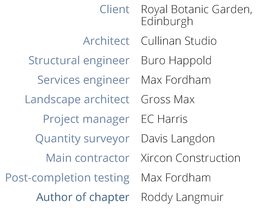

01 External view
The design takes its cue from the contours, paths and trees of the mature landscape of the Garden. It replaced buildings and paths at the west entrance, and juxtaposes built spaces with the mature arboretum all around. It had to minimise disturbance and open up new views. Rather than simply build an ‘object’ in the landscape, the aim was to create a ‘lens’ through which the plant world around it would be brought into focus.
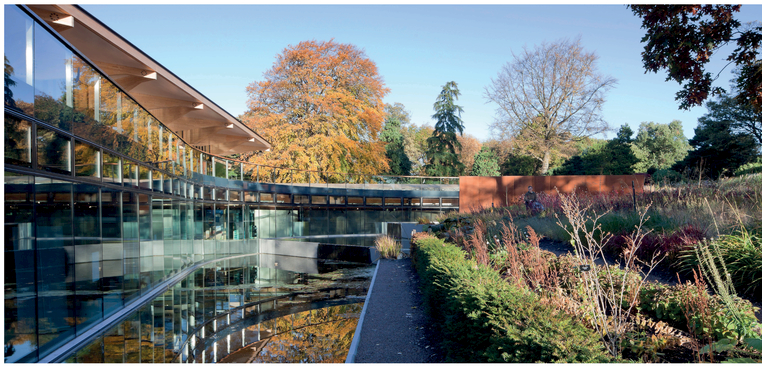
02 External view
RBGE looked to the John Hope Gateway to put across its messages about environmental sustainability, not just in its exhibitions but also through the design and fabric of the building itself.
Design approach
The entrance to the Gateway sits at an important crossing; the long axis through Inverleith Park leading up to the Inverleith House gallery, and the perimeter circular path around the Garden. Views into the Garden are framed by slate walls and the oversailing timber roof, while inside routes and views radiate outwards into the landscape.

03 Section
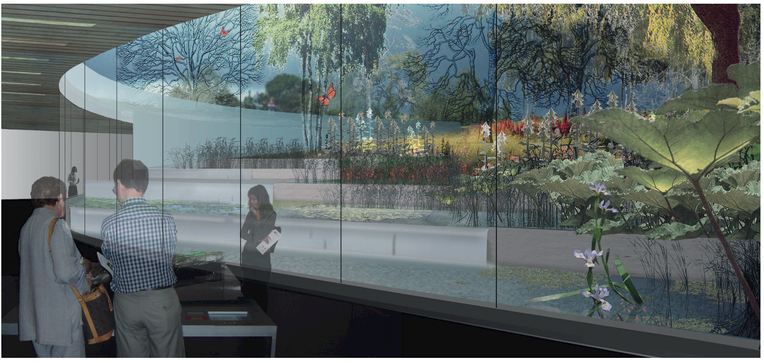
04 Visualisation of exhibition pools
Through a 60m curved glass wall you can see the new biodiversity garden. With plant species critical to biodiversity, it forms a living extension of the exhibition spaces. It can also be explored outside along a zigzag path, or seen from the external terraces on the upper floor (Figure 03).
Walls are Caithness stone off-cuts from the slabs that line Edinburgh’s streets, and the cladding is Scottish larch. The structure is engineered timber, and the cross-laminated roof panels and glulam beams float over the whole building as a single horizontal plane on pencil-thin steel columns. The roof is extended to create sheltered spaces. Its deep overhangs provide protection from rain and wind, so you can be outside to see and smell the garden whatever the weather.
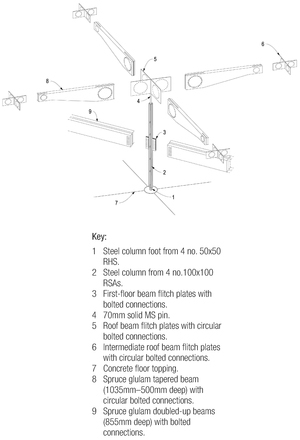
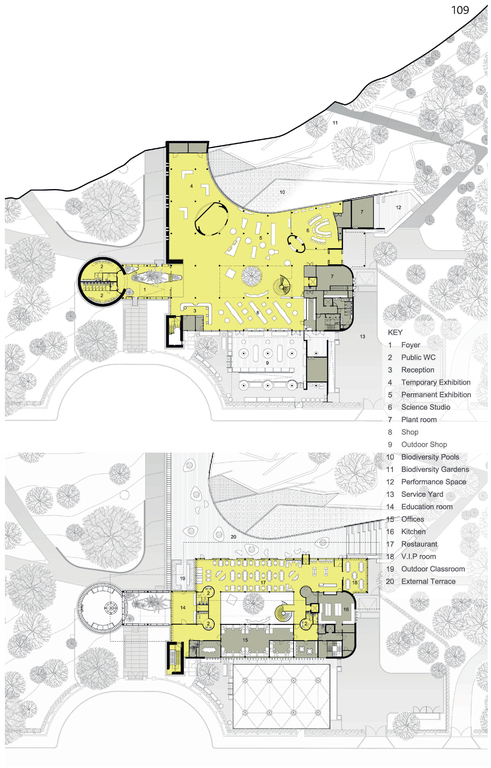
06 Ground-floor plan with biodiversity garden to the east (right side of image)
07 First-floor plan
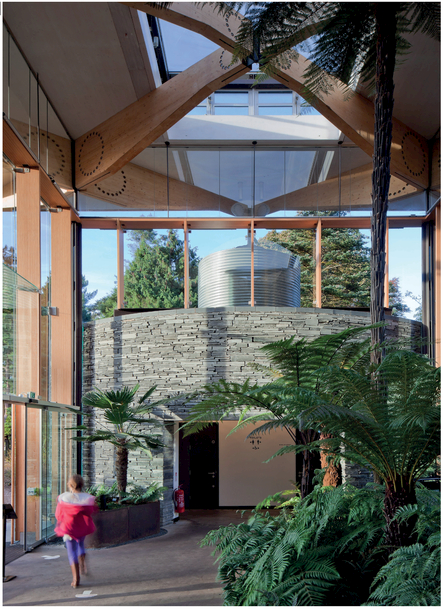
08 Internal view
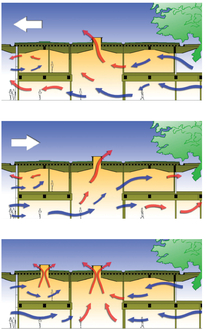
09 Ventilation diagrams: central atrium space and roof ventilators aid natural wind-driven and stack ventilation
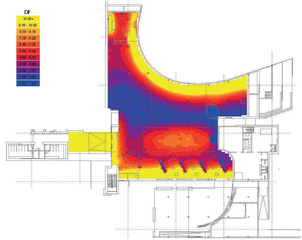
10 Ground-floor plan: daylight factors
Environmental design
The Gateway has been designed to demonstrate sustainability features through its exhibition content and by its construction. Environmental solutions include rainwater harvesting, a biomass boiler, solar thermal panels, roof-mounted photovoltaic (PV) panels and a wind turbine, a potent symbol of the environmental ethos of the Gateway.
The articulation of renewable systems and materials is an extension of the public mission of RBGE and its objective of promoting sustainable techniques. For example, rainwater collection follows a journey from roof, to tank, to WC cisterns – a journey that is on full display to the public (Figure 08).
Careful orientation, good daylighting, natural ventilation and high insulation levels all contribute to the building’s energy efficiency, while strong, durable, locally sourced natural materials guarantee a long life for the Gateway. It achieved an Energy Performance Certificate (EPC) with the highest (‘A’) rating (Figures 09 and 10).
A BREEAM assessment was not carried out. Instead the design team worked closely together to deliver a sustainable, low-energy, minimum-waste design with many demonstrable environmental features.
In order to ensure that the design team and client aspirations were aligned, the Design Quality Indicator (DQI) toolkit was used to map both the client’s and the design team’s attitudes in the early stages of the project. This was the first project to use DQI as an online tool.
Monitoring and post-occupancy feedback
The John Hope Gateway was the first largely government-funded project in Scotland to be procured following the highly publicised financial overruns of the Scottish Parliament. For this reason, despite the technical sophistication of the renewable techniques to be deployed and the demands of a refined detail design, the project was procured through a design and build contract, perceived as presenting ‘least risk’ to final capital cost.
However, in the context of a global and national recession, the main contractor went into receivership before completing the project. Complete commissioning of the mechanical and electrical systems did not happen, and it was not possible to assemble operation and maintenance manuals in the normal way.
Design and build contracts place more responsibility on the contractor, and therefore decisions on construction specification and installation are often managed without the knowledge or direct involvement of the design team. When contractors default, as happened in this case, clients are left without comprehensive installation, maintenance and monitoring information.
The Building Management System automatically reads all meters: gas, electricity and water. Max Fordham collated and analysed data during the testing and commisioning and extended remedial works. The Garden’s Facilities Management team would ideally monitor the meter readings on a monthly basis.
However RGBE do not have the capacity to employ a dedicated operator to check the efficiency of the systems on a daily basis, so when faulty building systems need attention, there can be a delay before such issues are identified. Owners or tenants of a building which uses solar and thermal energy - with PVs, wind turbines or biomass boilers – need to keep a close eye on these systems to ensure correct operation and speedy repairs. This fact needs to be impressed on clients considering the use of these complex renewable electrical and heating systems. The robustness of the PV panels has shown them to be an ideal renewable technology for a building with a limited maintenance staff, however the wind turbine has proved very problematic, requiring frequent maintenance and now is permanently out of action. Accurate energy predictions were made more difficult as the supplier was not able to provide data on the performance of the turbine that included the energy used to power up the turbine when it started.
The client has also had difficulty dealing with the lighting control system. Only the specialist contractor can alter or maintain the system, and this means that the RBGE electricians or other contractors are unable to fix lighting problems that occur. The use of a more traditional lighting control system that gave the client the ability to maintain it with in-house staff would have been more manageable.
A below-ground biomass silo was a problem, as the construction was poor and did not follow the design drawings. The resulting leaks have caused the woodchips to absorb water. This water ingress has also resulted in failures in the equipment, which has meant the building no longer operates the biomass boiler. In future it would be appropriate to use an internally lined silo that holds the woodchips away from the floor and walls, to ensure that any water from leaks does not come into contact with them.
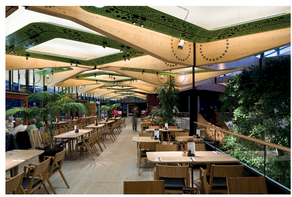
11 Internal view: restaurant
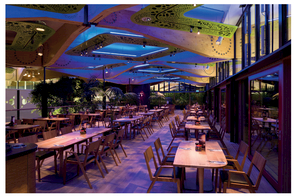
12 Internal view: night. The venue is a popular choice for hospitality events
The placement of egg-sized pebbles within the gutters to the sedum roof resulted in birds picking them up and dropping them, assuming they were eggs they could smash. One PV panel and several of the solar thermal tubes have been replaced after being hit. Chicken wire has since been installed over the stones to stop birds from picking them up.
The building relies on cross ventilation and thermal mass to maintain internal comfort conditions. This works in much of the building, however there are ongoing problems with overheating on the west-facing first floor.
Transformational lighting for evening hospitality events means that the changeover from day to evening is quick and effective. It has helped make the John Hope Gateway into a sustainable business, with hospitality income supporting the activities of the institution (Figures 11 and 12).
The potential of an exposed glulam and cross-laminated structure for major public projects (beyond domestic/schools) has been demonstrated, helping to promote renewable materials for larger construction projects in the UK. This has been well received by visitors and experts alike (Figure 13).
BMS data has been analysed and is detailed in the building energy graph. The data does not include information from any of the renewable technologies as there was either no data available (for the PV and solar thermal panels) or they are no longer operational (the biomass boiler and wind turbine). When the core building carbon emissions (those included in an EPC calculation, which exclude unregulated loads) are compared to a typical building, the John Hope Gateway building performs exceptionally well against the typical building, emitting 70% less carbon. However the total carbon emitted by the building (which includes unregulated loads) is much closer to that emitted by a typical building. This was due to the unexpected success of the building, with large numbers of visitors enjoying the facilities, increasing the catering use. Other areas such as display lighting were higher than the benchmarks. Overall this shows the importance of working with users to understand how to minimise energy use.
Conclusions
At the time of writing it is seven years since the completion and opening of the John Hope Gateway as a public building. It has been an enormous success – very popular with its visiting public, hosting a dynamic exhibition programme, and with a thriving catering and hospitality offer that sees the Gateway fully booked six months ahead.
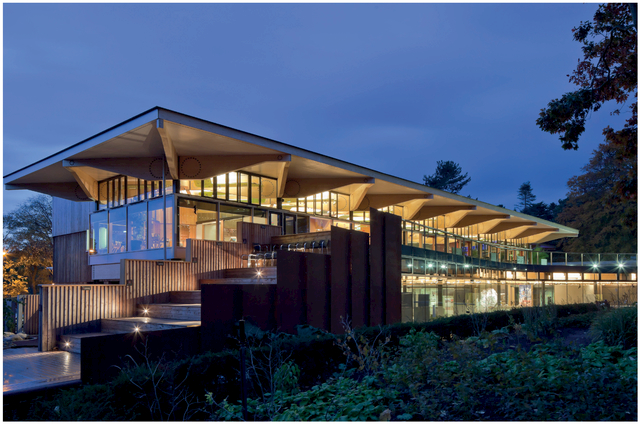
13 External view
This success is important, both in meeting the RBGE mission and in helping to fund the organisation as government grants are cut back. The high footfall has also ‘stressed’ the building, and this along with latent problems from its challenging beginnings, have meant the building has proved difficult to operate, particularly the multiple renewable technologies.
As is the case with many institutions the original briefing and estate management team have moved on, and at the time of writing the new team have set about a thorough review of the building and its environmental systems with the original design team. This will be an important opportunity to recalibrate the building systems and to assess those that have truly earned their keep.


14 Energy and carbon graphs

15 Energy by end use graph
